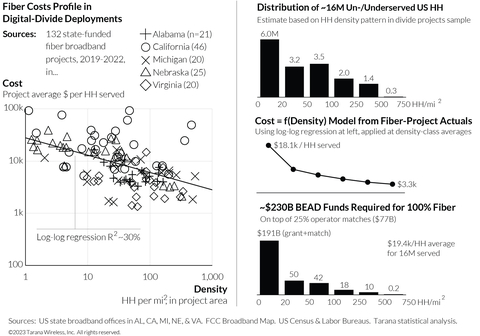Tarana Wireless, Inc. announced today the availability of a general cost estimation model for fiber broadband in US digital divide programs. The model is based on detailed public-domain data from 132 projects funded by state-level broadband offices since early 2019, in a set of 5 states (Alabama, California, Michigan, Nebraska, and Virginia) chosen to represent the wide range of fiber deployment conditions and challenges across the US. The projects were planned out to serve 52.7k households at an aggregate cost of $733.5M (an average of $13.9k per household) across a wide range of household densities and terrain.
This press release features multimedia. View the full release here: https://www.businesswire.com/news/home/20230417005335/en/

Tarana announced today the availability of a general cost estimation model for fiber broadband in US digital divide programs. Data from 132 recent projects shows clear need for next-generation fixed wireless. (Graphic: Business Wire)
The model’s development was motivated by a number of observations. First, while broadband service over fiber is ideal, there are situations where it is neither practical nor reasonable, due to high deployment costs and unacceptably long timelines to service. This is most clear in government-funded divide projects, where normal commercial business-case metrics do not suffice. Second, understanding clearly the costs of fiber is critical for policymakers, to ensure that objectives can be met with available funds. Third, unfortunately, gaining that understanding is challenging, given wide variations in fiber deployment methods, local circumstances, and hence real-world costs.
Tarana’s study solves this problem by tapping the data set of 132 representative divide projects to model the likely cost of fulfilling the intent of the broadband element of Congress’ 2021 Bipartisan Infrastructure Law, with its stated goal of reaching 100% of US households with fast, affordable internet service. Extrapolation from the past projects indicates that a fiber-only approach would cost well over $200B to connect the ~16M households that have been identified so far in the FCC’s current broadband re-mapping effort as un- or underserved. Obviously this far exceeds the $42.45B available in the Broadband Equity, Access, and Deployment program (BEAD) that is the broadband component of the Bipartisan Infrastructure Law.
Carl Guardino, VP of Government Affairs at Tarana, noted “A fiber-only diet isn’t healthy for people, and it’s equally unhealthy for fulfillment of America’s aspirations to provide universal access to high-capacity, reliable home broadband. The often-high costs and long deployment timelines of fiber in divide projects will leave millions of families unserved. Some interpret the BEAD Notice of Funding Opportunity (NOFO) in the context of the Bipartisan Infrastructure Law as fiber-only, which is unrealistic and the reason why states will need to exercise their rights to utilize both fiber and alternative technologies while still providing high quality broadband for all consumers. Harnessing the best technologies in the right balance is the only way to ensure state and federal funds serve 100 percent of their unserved (the stated goal of the law) and thereby best fulfill the needs of their communities and meet the equal-access provisions in the law.”
Claude Aiken, Chief Strategy Officer at Nextlink Internet (which is investing over $1 billion to provide high-speed broadband service to wide swaths of rural communities in 7 midwestern US states), added “Nextlink Internet is laser-focused on closing the digital divide in some of the most rural parts of America, and we need every tool in the toolkit to do just that. Cutting-edge fixed wireless technology allows us to exceed government speed metrics in existing subsidy programs, at a lower cost to both the government and the consumer. Fiber is a fantastic tool for connecting communities, but we need an all-of-the-above approach to get affordable broadband to everyone.”
The key takeaway from Tarana’s fiber study is that an approach that leverages multiple technologies — beyond just fiber — is essential. In particular, tapping next-generation fixed wireless access (ngFWA) platforms — such as Tarana’s G1 family — will help BEAD programs serve more families with fast, reliable broadband at much lower cost and on shorter timelines. With their broadband-specific design (in contrast to 5G) and unique ability to combine operation in licensed mid-band spectrum while tapping 850 MHz of 6 GHz spectrum, G1-powered networks will support traffic growth far into the future.
Tarana welcomes you to visit https://www.taranawireless.com/fiber-study for more details on the team’s US fiber-completion data collection and analysis.
In addition, for policymakers and others interested in seeing ngFWA in action, Tarana would like to invite you to a special event in Sacramento, CA, April 18th, where the unique non-line-of-sight and interference-mitigation capabilities of Tarana’s G1 ngFWA platform will be showcased in a live demo next to California’s state capitol building. See our event landing page for more info.
About Tarana
Tarana’s mission is to accelerate the deployment of fast, affordable internet access around the world. Through a decade of R&D and more than $400M of investment, the Tarana team has created a unique next-generation fixed wireless access (ngFWA) technology instantiated in its first commercial platform, Gigabit 1 (G1). It delivers a game-changing advance in broadband economics in both mainstream and underserved markets, using either licensed or unlicensed spectrum. G1 started production in mid-2021 and has since been embraced by more than 220 service providers in 19 countries. Tarana is headquartered in Milpitas, California, with additional research and development in Pune, India. Visit www.taranawireless.com for more on G1.
View source version on businesswire.com: https://www.businesswire.com/news/home/20230417005335/en/